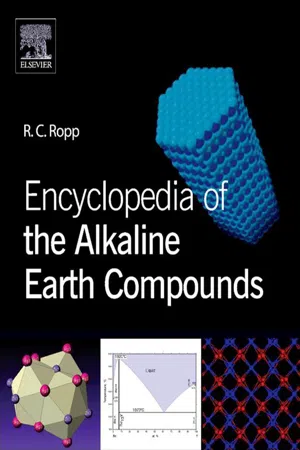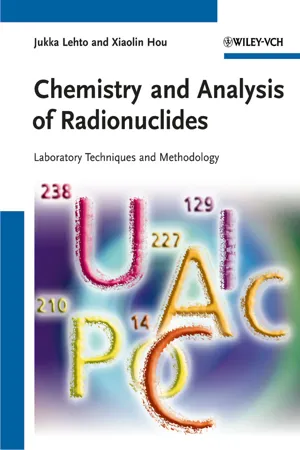Chemistry
Group 2 Alkaline Metals
Group 2 alkaline metals are a set of metallic elements in the periodic table, including beryllium, magnesium, calcium, strontium, barium, and radium. They are known for their high reactivity and tendency to form 2+ cations. These metals are typically found in compounds rather than in their pure form and are important in various industrial and biological processes.
Written by Perlego with AI-assistance
7 Key excerpts on "Group 2 Alkaline Metals"
- eBook - ePub
Essentials of Inorganic Chemistry
For Students of Pharmacy, Pharmaceutical Sciences and Medicinal Chemistry
- Katja A. Strohfeldt(Author)
- 2015(Publication Date)
- Wiley(Publisher)
Chapter 3 Alkaline Earth MetalsMembers of group 2 of the periodic table (second vertical column) are calledearth alkaline metals. In this group are included the following elements: beryllium (Be), magnesium (Mg), calcium (Ca), strontium (Sr), barium (Ba) and radium (Ra). Radium is a radioactive element and therefore we will not further discuss it in this chapter (Figure 3.1 ).Periodic table of elements; group 2 elements are highlightedFigure 3.1In terms of clinical use, magnesium and calcium are essential ions for the human body and any of their imbalances should be corrected. Strontium is medically used in radiotherapy, and its application is further discussed in Chapter 10. Exposure to excess beryllium can lead to the so-called chronic beryllium disease (CBD), which is discussed later in this chapter. Barium salts are generally highly toxic. Nevertheless, the so-called barium meal is a well-used oral radio-contrast agent.3.1 Earth alkaline metal ions
Earth alkaline metals together with the alkali metals form the so-called s-block metals. Earth alkaline metals have two electrons in their outer shell which is an s-orbital type. The chemistry of the metals is characterised by the loss of both electrons, which is a result of the relatively low ionisation energy (IE) of both electrons and the subsequent formation of the stable cation M2+ , which has a noble gas configuration (Table 3.1 ).Source: Reproduced with permission from [8]. Copyright © 1996, John Wiley & Sons, Ltd.First, second and third ionisation energies (kJ/mol) of group 2 metals [1]Table 3.1First Second Third Be 900 1 757 14 847 Mg 738 1 450 7 731 Ca 590 1 145 4 910 Sr 550 1 064 4 207 Ba 503 965 3 600 Group 2 elements are all silvery-white metals with high reactivity, similar to alkali metals, but less soft and not as reactive. Earth alkaline metals can be mostly found in the earth's crust in the form of their cations displayed in minerals and not as the elemental metal, as these are very reactive. For example, beryllium principally occurs as beryl (Be3 Al2 [Si6 O18 ]), which is also known asaquamarine - eBook - ePub
- Richard C. Ropp(Author)
- 2012(Publication Date)
- Elsevier(Publisher)
Chapter 1 The Alkaline Earths as Metals Outline1.1. General Properties1.2. Properties of the Alkaline Earth Metals1.2.1. Beryllium1.2.2. Magnesium1.2.3. Calcium1.2.4. Strontium1.2.5. Barium1.2.6. RadiumThe alkaline earth metals comprise Group 2 of the periodic table and include the elements Be, Mg, Ca, Sr, Ba and Ra. These metals form cations with a formal charge of +2 in solution and are the second most electropositive metals of all of the elements (the alkali metals are the most electropositive). The name of this specific group in the periodic table stems from the fact that their oxides produce basic alkaline solutions and that these elements melt at such high temperatures that they remain solid (earths) in fires. The alkaline earth metals provide a good example of group trends in chemical properties within the periodic table, with well-characterized homologous behavior as one goes down the group. With the exception of Be and Mg, the metals have a distinguishable flame color, orange-red for Ca, magenta-red for Sr, green for Ba and crimson-red for Ra.1.1 General Properties
Like other groups, the members of this family show specific patterns in their electron configuration, especially the outermost shells, that results in trends in chemical behavior (Table 1.1 ).TABLE 1.1Z Element No. of electrons/shell 4 Beryllium 2, 2 12 Magnesium 2, 8, 2 20 Calcium 2, 8, 8, 2 38 Strontium 2, 8, 18, 8, 2 56 Barium 2, 8, 18, 18, 8, 2 88 Radium 2, 8, 18, 32, 18, 8, 2 Another way to depict the electronic structure of these elements is shown in Table 1.2 .TABLE 1.2Element Symbol Electronic configuration Beryllium Be [He]2s2 Magnesium Mg [Ne]3s2 Calcium Ca [Ar]4s2 Strontium Sr [Kr]5s2 Barium Ba [Xe]6s2 Radium Ra [Rn]7s2 All of the alkaline earth metals have two electrons in their outer valence shell, so the energetically preferred state of achieving a filled electron shell is to lose two electrons to form doubly charged cations, M2+ - eBook - ePub
Chemistry
With Inorganic Qualitative Analysis
- Therald Moeller(Author)
- 2012(Publication Date)
- Academic Press(Publisher)
Table 26.1 ) increase with increasing atomic weight. Paralleling this trend, the melting points and boiling points decrease as the atoms become larger and heavier, and the forces holding the atoms in the metal lattice decrease. The alkali metals have lower melting and boiling points and also lower densities, than most other metals. In addition, they are soft; all except lithium easily can be cut with a knife. When freshly cut they have a characteristic metallic luster, but on exposure to air they soon tarnish by rapidly reacting with atmospheric gases.The alkaline earth metals—Representative Group II , also known as the beryllium family elements—also have a high degree of reactivity, second only to that of their Group I neighbors. Beryllium is covalent in most of its compounds because of the large amount of energy needed to form Be2+ . Magnesium sometimes forms at least partially covalent bonds, but the remaining alkaline earth elements react almost exclusively to form dipositive ions, for example, Ca2+ and Ba2+ , and to give ionic compounds. In both groups, thelarger the atom, the more easily it gives up its valence electrons and the greater is its reactivity.The trends in physical properties are generally the same for the elements of Group II as for those of Group I. Atoms and ions of the Group II elements have smaller radii than their respective alkali metal neighbors, reflecting their greater effective nuclear charge. Group II elements are denser and have higher melting and boiling points, and they are much harder—all properties derived from greater interatomic forces in the solid state.The ease with which the elements of both groups form ions is reflected both in their ionization energies , which are low, and their standard reduction potentials (Table 26.2 ), which show that these elements are among the strongest of all reducing agents (compare with values in Table 19.6 - eBook - ePub
Chemistry
Concepts and Problems, A Self-Teaching Guide
- Richard Post, Chad Snyder, Clifford C. Houk(Authors)
- 2020(Publication Date)
- Jossey-Bass(Publisher)
noble gas family. An element in Group VIIIA may be generalized by its family name as a(n) (noble gas, alkaline earth, alkali metal) _______.Answer: noble gasGroup IA on the left side of the chart is often called by the family name of alkali metals (with the exception of hydrogen). These elements can react vigorously with water to form strong alkaline solutions. If a friend told you that aluminum (Al) was an alkali metal, would he be right or wrong? _________Answer: wrong (Aluminum is located in Group IIIA and the alkali metals are all located in Group IA.)Group IIA elements are known as the alkaline earth metals because the oxides of these metals (chemical compounds of the metals and oxygen) form alkaline solutions in water. The element potassium (K) can be classified as a(n) (noble gas, alkaline earth, alkali metal) _________.Answer: alkali metal (Group IA)The element Ba (barium) can be classified as a(n) (alkali metal, alkaline earth, or noble gas) _________.Answer: alkaline earth (Group IIA)An unknown element is placed in water. A vigorous reaction takes place, and the result is an alkaline solution. Of which family is the element probably a member: alkaline earth, alkali metal, or noble gas?__________Answer: alkali metal (Alkali metals react directly with water to form alkaline solutions. The oxides of alkaline earth elements react with water to form alkaline solutions.)The elements in Group VIIA are known as the halogens, which means “salt formers.” Elements from the halogen family combine with metals to form compounds known as salts. Common table salt (NaCl) is made up of sodium (Na) and chlorine (Cl). These two elements (Na and Cl) are members of what families or groups?- Na: _________
- Cl: _________
Answer: Group IA, the alkali metals (either answer is acceptable); Group VIIA, the halogens (either answer is acceptable). - eBook - ePub
Chemistry and Analysis of Radionuclides
Laboratory Techniques and Methodology
- Jukka Lehto, Xiaolin Hou(Authors)
- 2011(Publication Date)
- Wiley-VCH(Publisher)
Chapter 7 Radiochemistry of the Alkaline Earth Metals7.1 Most Important Radionuclides of the Alkaline Earth MetalsFrom the point of view of radiochemistry and radioactivity in the environment, the most important radionuclides of the alkaline earth metals are , originating in nuclear weapons testing, the Chernobyl accident, and nuclear waste, and the and isotopes generated in the natural radioactive decay series. is a pure beta emitter, while the isotopes of radium are alpha and beta emitters. Consequently, they all require radiochemical separations before counting. The third radionuclide of interest in radiochemical separations is the very long-lived isotope of calcium, , formed as an activation product in nuclear waste. The important radionuclides of the alkaline earth metals are listed in Table 7.1 and are discussed below.Table 7.1 Important radionuclides of the alkaline earth metals7.2 Chemical Properties of the Alkaline Earth MetalsThe alkaline earth metals belong to group 2 of the periodic table and have 2 s-orbital electrons in their outer shell. They form compounds in oxidation state +II and appear in aqueous solutions as M2+ ions. Alkaline earth metals are moderately electropositive, but less electropositive than the alkali metals since their charge is twice as large. The electropositivity of the alkaline earth metals increases with the atomic number as follows: Be < Mg < Ca < Sr < Ba < Ra (Table 7.2 ). Because they are electropositive, the alkaline earth metals, like the alkali metals, mostly form ionic bonds, and most of their common compounds, like halides, are highly soluble, though quite a number are sparingly soluble. Beryllium is exceptional among the alkaline earth metals in its very small ion size (ionic radius 31 pm), and therefore it forms compounds with covalent bonds. In their ion size the alkaline earth metals follow the same trend as the alkali metals: the ion size increases with atomic number (Table 7.2 - No longer available |Learn more
MCAT General Chemistry Review 2024-2025
Online + Book
- (Author)
- 2023(Publication Date)
- Kaplan Test Prep(Publisher)
The alkali metals have only one loosely bound electron in their outermost shells. Their Z eff values are very low, giving them the largest atomic radii of all the elements in their respective periods. This low Z eff value also explains the other trends: low ionization energies, low electron affinities, and low electronegativities. Alkali metals easily lose one electron to form univalent cations, and they react readily with nonmetals—especially the halogens—as in NaCl. Figure 2.11 illustrates the reaction of an alkali metal with water, a stereotypically violent reaction. Figure 2.11. Re a ction of Sodium with Water Group IA metals react violently with water, forming strong bases. REAL WORLD Due to their high reactivity with water and air, most alkali metals are stored in mineral oil. Alkaline Earth Metals (IIA) The alkaline earth metals (Group IIA or Group 2) also possess many properties characteristic of metals. They share most of the characteristics of the alkali metals, except that they have slightly higher effective nuclear charges and thus slightly smaller atomic radii. They have two electrons in their valence shell, both of which are easily removed to form divalent cations. Together, the alkali and alkaline earth metals are called the active metals because they are so reactive that they are not naturally found in their elemental (neutral) state. Chalcogens (VIA) The chalcogens (Group VIA or Group 16) are an eclectic group of nonmetals and metalloids. While not as reactive as the halogens, they are crucial for normal biological functions. They each have six electrons in their valence electron shell and, due to their proximity to the metalloids, generally have small atomic radii and large ionic radii. Oxygen is the most important element in this group for many reasons; it is one of the primary constituents of water, carbohydrates, and other biological molecules. Sulfur is also an important component of certain amino acids and vitamins - eBook - ePub
- Jeffrey Gaffney, Nancy Marley(Authors)
- 2017(Publication Date)
- Elsevier(Publisher)
An understanding of this periodicity of the chemical properties of the elements allowed chemists to predict how elements would combine and how they would behave when reacting with other elements. The development of the Periodic Table of the Elements can thus be compared to the discovery of the “Rosetta Stone,” which provided the key to the translation of ancient languages into modern text and for the first time allowed scholars to be able to understand the meaning of ancient documents. Similarly, the periodic table effectively organizes the elements into classes according to their electronic configurations, providing the key to understanding and predicting the chemical behavior of the elements. In order to effectively use the periodic table to predict chemical properties and behavior of the elements, it is important to first know how its structure relates to electronic configurations.The general layout of the modern periodic table is shown in Fig. 1.12 . It arranges the elements in vertical columns called groups. There are 18 groups in the periodic table numbered 1–18. Elements in the same group generally share the same chemical properties with clear trends associated with increasing atomic number going down a group. Some groups are known by family names to indicate the similar properties that they share. Group 1 is called the alkali metals (lithium, sodium, potassium, rubidium, cesium, and francium). Group 2 is known as the alkaline earth metals (beryllium, magnesium, calcium, strontium, barium, and radium). Group 17 is the halogens (fluorine, chlorine, bromine, iodine, and astatine) and group 18 is the noble gases (helium, neon, argon, krypton, xenon, and radon). Elements in groups 3–12 are known collectively as the transition metals.The elements are also arranged in seven horizontal rows called periods because the periodic properties of the elements increase systematically with increasing atomic number going across a row. There are seven periods in the periodic table numbered 1–7. The number of each period corresponds to the principal quantum number of the outermost electron shell containing electrons for all elements in the period. So, the elements in period 1 contain electrons only in the n = 1 shell, while the elements in period 2 contain electrons in the n = 1 and n = 2 shells, and elements in period 3 contain electrons in the n
Index pages curate the most relevant extracts from our library of academic textbooks. They’ve been created using an in-house natural language model (NLM), each adding context and meaning to key research topics.
Explore more topic indexes
Explore more topic indexes
1 of 6
Explore more topic indexes
1 of 4






